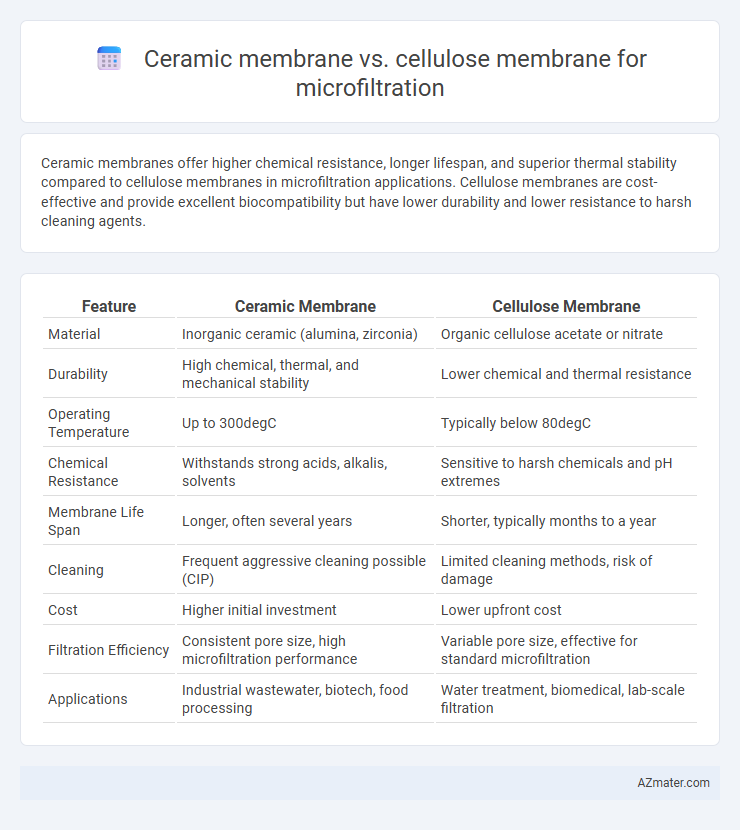Ceramic membranes offer higher chemical resistance, longer lifespan, and superior thermal stability compared to cellulose membranes in microfiltration applications. Cellulose membranes are cost-effective and provide excellent biocompatibility but have lower durability and lower resistance to harsh cleaning agents.
Table of Comparison
| Feature | Ceramic Membrane | Cellulose Membrane |
|---|---|---|
| Material | Inorganic ceramic (alumina, zirconia) | Organic cellulose acetate or nitrate |
| Durability | High chemical, thermal, and mechanical stability | Lower chemical and thermal resistance |
| Operating Temperature | Up to 300degC | Typically below 80degC |
| Chemical Resistance | Withstands strong acids, alkalis, solvents | Sensitive to harsh chemicals and pH extremes |
| Membrane Life Span | Longer, often several years | Shorter, typically months to a year |
| Cleaning | Frequent aggressive cleaning possible (CIP) | Limited cleaning methods, risk of damage |
| Cost | Higher initial investment | Lower upfront cost |
| Filtration Efficiency | Consistent pore size, high microfiltration performance | Variable pore size, effective for standard microfiltration |
| Applications | Industrial wastewater, biotech, food processing | Water treatment, biomedical, lab-scale filtration |
Introduction to Microfiltration Membranes
Microfiltration membranes serve as critical components in separating particles typically ranging from 0.1 to 10 microns, essential for water treatment, biotechnology, and food processing industries. Ceramic membranes offer superior chemical, thermal, and mechanical stability, enabling operation in harsh conditions and aggressive cleaning cycles. Cellulose membranes, derived from natural polymers, provide cost-effective solutions with good permeability but lower resistance to extreme pH and temperature variations, making them suitable for less demanding applications.
Overview of Ceramic and Cellulose Membranes
Ceramic membranes exhibit superior chemical, thermal, and mechanical stability, making them ideal for harsh microfiltration applications and extended operational life. Cellulose membranes, derived from natural polymers, offer cost-effective and biodegradable solutions with good permeability but limited chemical resistance and durability. Both types serve critical roles in microfiltration, with ceramic membranes excelling in industrial processes and cellulose membranes preferred for biomedical and food-related applications.
Material Composition and Structure Comparison
Ceramic membranes for microfiltration are composed of inorganic materials such as alumina, zirconia, or titanium oxide, offering superior chemical and thermal stability compared to cellulose membranes, which are made from organic polymer fibers like regenerated cellulose or cellulose acetate. The rigid, porous structure of ceramic membranes provides higher mechanical strength and resistance to fouling, enabling repeated cleaning cycles and longer service life. In contrast, cellulose membranes feature a more flexible, fibrous matrix with lower tolerance to harsh chemicals and temperature, making them suitable for milder filtration applications.
Filtration Efficiency and Performance
Ceramic membranes exhibit higher filtration efficiency and durability in microfiltration due to their uniform pore size distribution and chemical resistance, enabling superior removal of fine particles and contaminants. Cellulose membranes, though cost-effective and flexible, often suffer from lower mechanical strength and reduced lifespan, impacting long-term performance and requiring frequent replacement. The robust nature of ceramic membranes supports consistent flux rates and easier cleaning, making them well-suited for demanding industrial microfiltration applications.
Mechanical Strength and Durability
Ceramic membranes exhibit superior mechanical strength compared to cellulose membranes, making them highly resistant to abrasive and high-pressure conditions in microfiltration processes. Their inorganic composition provides exceptional durability, allowing for repeated cleaning cycles without performance degradation, unlike cellulose membranes which are prone to swelling and mechanical damage. This robustness translates to longer operational lifespan and lower replacement frequency, enhancing overall process reliability and cost-effectiveness.
Chemical and Thermal Resistance
Ceramic membranes demonstrate superior chemical resistance, enduring aggressive solvents, strong acids, and alkalis without degradation, unlike cellulose membranes that are prone to chemical attack and swelling. Thermal resistance further distinguishes ceramic membranes, as they withstand high temperatures up to 900degC, whereas cellulose membranes typically degrade above 60-80degC. This resilience makes ceramic membranes ideal for harsh industrial microfiltration applications requiring prolonged exposure to extreme chemical and thermal conditions.
Fouling Propensity and Cleaning Methods
Ceramic membranes exhibit lower fouling propensity compared to cellulose membranes due to their smoother surfaces and higher chemical resistance, allowing them to handle aggressive cleaning protocols such as backflushing, chemical cleaning with strong acids, alkalis, and oxidants without degradation. Cellulose membranes, prone to organic fouling and biofouling, require gentler cleaning methods like mild detergents or enzymatic solutions to prevent structural damage and maintain filtration efficiency. The robust mechanical and chemical stability of ceramic membranes extends their lifespan and reliability in microfiltration applications with high fouling potential.
Environmental Impact and Sustainability
Ceramic membranes exhibit superior environmental sustainability compared to cellulose membranes due to their longer lifespan, chemical resistance, and ability to withstand harsh cleaning processes, reducing frequency of replacement and waste generation. Cellulose membranes, derived from natural polymers, offer biodegradable properties but often require more frequent disposal and chemical treatments that may impact ecosystems. The inorganic composition and recyclability of ceramic membranes contribute to lower environmental footprints in microfiltration applications, enhancing sustainable water treatment practices.
Cost Analysis and Economic Considerations
Ceramic membranes exhibit higher initial capital costs compared to cellulose membranes due to advanced materials and manufacturing processes, but their longer lifespan and superior chemical resistance reduce replacement frequency and operational downtime, leading to lower total cost of ownership in the long term. Cellulose membranes offer lower upfront investment and are more cost-effective for short-term or disposable applications, though they incur higher maintenance expenses and vulnerability to fouling and chemical degradation. Economic considerations favor ceramic membranes in industrial microfiltration applications requiring durability and sustained performance, while cellulose membranes remain viable for lower-budget or less demanding filtration needs.
Applications and Suitability in Industry
Ceramic membranes offer superior chemical and thermal stability, making them ideal for harsh industrial microfiltration applications such as wastewater treatment, food and beverage processing, and pharmaceutical manufacturing. Cellulose membranes, known for their biodegradability and lower cost, are commonly used in less aggressive environments like laboratory filtration and low-temperature food processing. The choice between ceramic and cellulose membranes depends on the specific chemical resistance, temperature tolerance, and operational lifespan required by the industry.

Infographic: Ceramic membrane vs Cellulose membrane for Microfiltration
 azmater.com
azmater.com